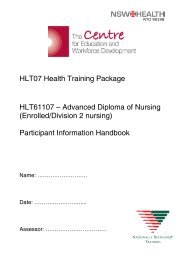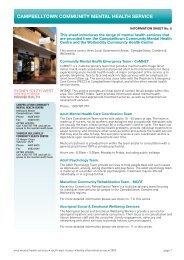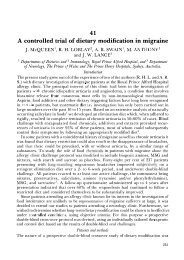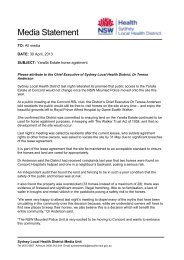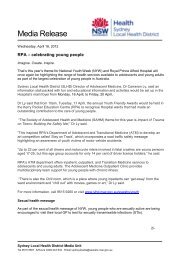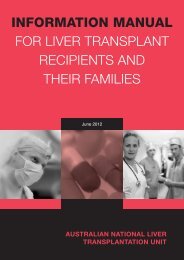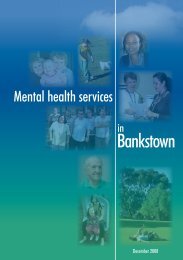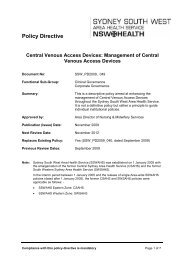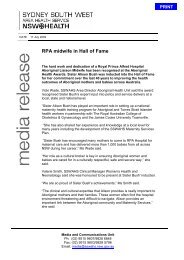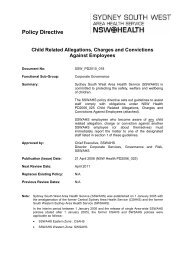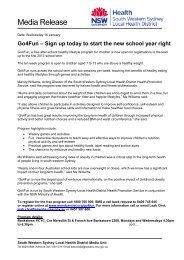Food and Nutrition - Sydney South West Area Health Service
Food and Nutrition - Sydney South West Area Health Service
Food and Nutrition - Sydney South West Area Health Service
Create successful ePaper yourself
Turn your PDF publications into a flip-book with our unique Google optimized e-Paper software.
Policy Directive<strong>Food</strong> <strong>and</strong> <strong>Nutrition</strong>Document No:Functional Sub-Group:Summary:Approved by:SSW_PD2009_030Clinical GovernanceCorporate GovernancePolicy for acceptable food <strong>and</strong> nutrition st<strong>and</strong>ards that willassist in addressing issues associated with hospitalmalnutrition <strong>and</strong> ensure delivery of optimal nutritional carefor all patients.Director Corporate <strong>Service</strong>sClinical Council (25/8/09)Publication (Issue) Date: September 2009Next Review Date: September 2012Replaces Existing Policy:Previous Review Dates:N/AN/ANote:<strong>Sydney</strong> <strong>South</strong> <strong>West</strong> <strong>Area</strong> <strong>Health</strong> <strong>Service</strong> (SSWAHS) was established on 1 January 2005 withthe amalgamation of the former Central <strong>Sydney</strong> <strong>Area</strong> <strong>Health</strong> <strong>Service</strong> (CSAHS) <strong>and</strong> the former<strong>South</strong> <strong>West</strong>ern <strong>Sydney</strong> <strong>Area</strong> <strong>Health</strong> <strong>Service</strong> (SWSAHS).In the interim period between 1 January 2005 <strong>and</strong> the release of single <strong>Area</strong>-wide SSWAHSpolicies (dated after 1 January 2005), the former CSAHS <strong>and</strong> SWSAHS policies wereapplicable as follows:-• SSWAHS Eastern Zone : CSAHS• SSWAHS <strong>West</strong>ern Zone: SWSAHSCompliance with this policy directive is m<strong>and</strong>atory Page 1 of 15
<strong>Sydney</strong> <strong>South</strong> <strong>West</strong> <strong>Area</strong> <strong>Health</strong> <strong>Service</strong>Policy No: SSW_PD2009_030Date Issued: September 2009FOOD AND NUTRITIONCONTENTS1. Background – <strong>Food</strong> <strong>and</strong> <strong>Nutrition</strong> in <strong>Health</strong> 32. Hospital Malnutrition – Incidence <strong>and</strong> consequence 33. Policy Statement 44. The Integrated <strong>Food</strong> <strong>and</strong> <strong>Nutrition</strong> System 55. St<strong>and</strong>ards of Care 66. Definitions 137. References 13Compliance with this policy directive is m<strong>and</strong>atory page 2 of 15
<strong>Sydney</strong> <strong>South</strong> <strong>West</strong> <strong>Area</strong> <strong>Health</strong> <strong>Service</strong>Policy No: SSW_PD2009_030Date Issued: September 2009FOOD AND NUTRITION1. Background – <strong>Food</strong> <strong>and</strong> <strong>Nutrition</strong> in <strong>Health</strong>Good nutrition is important for everyone, but particularly for those who are ill or aresuffering from injury. The provision of good nutrition is an integral aspect of good clinicalcare <strong>and</strong> is associated with better patient outcomes. 1-3 For hospital patients, maintaininggood nutritional status or, for those who are malnourished, gaining nutritional repletion,relies on the ability of the hospital to provide foods which are both nourishing <strong>and</strong>acceptable to patients in terms of their cultural <strong>and</strong> psychosocial needs. In order toachieve the best outcomes for the patient other issues such as patient access to foods<strong>and</strong> assistance with eating so that the food offered to the patient can be consumed, alsoneed to be addressed.<strong>Food</strong> is not only essential for physical health it is also integral to the individual’s sense ofself 4 <strong>and</strong> has strong psychological connotations associated with nurturing 5 . When aperson is admitted to hospital frequently, the only familiar thing <strong>and</strong> one of the few thingsthe patient feels qualified to evaluate, is the food. Familiar foods are important in highlystressful situations, such as being in hospital, as they represent comfort <strong>and</strong> security tothe individual 6 . Although hospital food services are constrained by limitations such assystems of food preparation <strong>and</strong> distribution; <strong>and</strong> the statutory requirements of providingsafe food to the patients; they have a duty of care to meet the nutritional requirements<strong>and</strong> the psychosocial needs of each patient. All staff can contribute to making thehospital mealtime environment pleasant <strong>and</strong> can assist patients in accessing <strong>and</strong>enjoying their meals. Patients’ perceptions of hospital food quality have a strongcorrelation with their satisfaction with medical treatment <strong>and</strong> the hospital stay overall 7 .2. Hospital Malnutrition – Incidence & ConsequencesHospital malnutrition is a world-wide phenomenon which is multifactorial in its origin 2-3,8-12 . While many patients are malnourished on admission, patients’ nutritional status mayalso worsen during the course of admission 13 .Malnutrition in hospital may go undetected <strong>and</strong>, if untreated, cause a wide range ofadverse outcomes for the patient <strong>and</strong> for the health system.For the individual:• Apathy <strong>and</strong> depression• Dehydration• Delayed wound healing• Diarrhoea, constipation• Impaired metabolic profiles• Impaired mobility• Increased prevalence of both adverse drug reactions <strong>and</strong> drug interactions• Increased risk of pressure ulcers• Infection• Muscle wasting <strong>and</strong> weaknessCompliance with this policy directive is m<strong>and</strong>atory page 3 of 15
<strong>Sydney</strong> <strong>South</strong> <strong>West</strong> <strong>Area</strong> <strong>Health</strong> <strong>Service</strong>Policy No: SSW_PD2009_030Date Issued: September 2009For the health system, malnutrition contributes to increased:• Clinical intervention• Complications• Costs• Lengths of stay• Rates of readmission• Staff time per patient• Use of antibiotics 1-3,8-132.1 The Risks Addressed by this Policy• Morbidity <strong>and</strong> mortality from malnutrition.• Increased length of stay <strong>and</strong> costs as a result of the complications associatedwith inadequate nutritional care.2.2 The Aims / Expected Outcomes of this Policy• All patients receive appropriate, safe <strong>and</strong> adequate nutritional care which isconsistent with their medical condition <strong>and</strong> with evidence-based best practiceguidelines.• Patients who are malnourished, or at risk of malnutrition, are identified <strong>and</strong>referred for appropriate assessment <strong>and</strong> management.• Patients will continue to be monitored for risk of malnutrition throughout theiradmission so that any required intervention occurs as early as possible.• Patients <strong>and</strong> families receive education, as appropriate, with respect to anydietary modifications or nutritional interventions.3. Policy Statement1. <strong>Food</strong> <strong>and</strong> nutrition are recognised as an essential part of patient care <strong>and</strong> increating positive experiences in the health service 14 .2. Patients’ nutritional <strong>and</strong> dietary requirements are identified, documented <strong>and</strong>communicated in an effective <strong>and</strong> timely manner.3. <strong>Food</strong> <strong>and</strong> fluids provided meet the nutritional, clinical, therapeutic <strong>and</strong> psychosocialneeds of patients.4. <strong>Food</strong> service provision is customised to meet the requirements of particular clientgroups.5. <strong>Nutrition</strong>al screening, assessment, care planning, documentation <strong>and</strong> monitoring ofnutritional status occur on admission <strong>and</strong> throughout the patients hospital stay.6. The mealtime environment is conducive to eating.7. Patients receive the assistance <strong>and</strong> encouragement they require when eating ordrinking.Compliance with this policy directive is m<strong>and</strong>atory page 4 of 15
<strong>Sydney</strong> <strong>South</strong> <strong>West</strong> <strong>Area</strong> <strong>Health</strong> <strong>Service</strong>Policy No: SSW_PD2009_030Date Issued: September 20098. Staff, carers <strong>and</strong> volunteers who are involved in the delivery of food <strong>and</strong>/orassistance of patients at meal times receive appropriate education <strong>and</strong> training tosupport them in this function.9. Patients, carers <strong>and</strong> staff have the opportunity of providing feedback that informsthe development of policies <strong>and</strong> practices in the delivery of food <strong>and</strong> nutritionservices.10. Consideration is given to other factors including medications, drug/nutrientinteractions, fasting <strong>and</strong> end of life nutrition issues.4. The Integrated <strong>Food</strong> <strong>and</strong> <strong>Nutrition</strong> SystemThe diagram below summarises the connections between all key aspects of nutritionalcare. The complexity of this diagram reflects how integral the relationship betweenclinical <strong>and</strong> support services is to achieve best patient care.The patientReassessReassessConduct nutritionscreeningPatient deemed malnourishedor ‘at risk’ of malnutritionDevelop care planConduct full nutritionalassessment<strong>Food</strong> &<strong>Nutrition</strong>St<strong>and</strong>ardsPrescribe appropriate dietProcure / prepare foodDelivery of patient mealOrganise nutritional supportOrganise assistance witheatingEducate <strong>and</strong> pl<strong>and</strong>ischargeFollow upCompliance with this policy directive is m<strong>and</strong>atory page 5 of 15
<strong>Sydney</strong> <strong>South</strong> <strong>West</strong> <strong>Area</strong> <strong>Health</strong> <strong>Service</strong>Policy No: SSW_PD2009_030Date Issued: September 20095. St<strong>and</strong>ards of Care5.1 <strong>Food</strong> <strong>and</strong> nutrition are recognised as an essential part of patient care <strong>and</strong> increating positive experiences in the health service.RationaleAn area-wide strategic <strong>and</strong> coordinated approach is necessary to ensure a highst<strong>and</strong>ard of nutritional care is provided to patients in all facilities.Criteria• Executive <strong>and</strong> senior management staff of SSWAHS recognise that food <strong>and</strong>nutrition are an essential part of patient care.• Executive <strong>and</strong> senior management staff of SSWAHS support theimplementation of the ‘SSWAHS <strong>Food</strong> <strong>and</strong> <strong>Nutrition</strong> Policy’.• Executive <strong>and</strong> senior management staff of SSWAHS endorse the requirementof resource allocation <strong>and</strong> adequately trained staff that underpins theimplementation of the ‘SSWAHS <strong>Food</strong> <strong>and</strong> <strong>Nutrition</strong> Policy’.5.2 Patients’ nutritional <strong>and</strong> dietary requirements are identified, documented <strong>and</strong>communicated in an effective <strong>and</strong> timely manner.RationaleEffective <strong>and</strong> timely communication relating to the patient’s nutritional <strong>and</strong> dietaryrequirements, nutritional care plan <strong>and</strong> related management strategies is essentialto maintain patient safety. Systems <strong>and</strong> processes must be in place to ensure thatthis occurs.Criteria• Patients’ nutritional <strong>and</strong> dietary requirements are identified upon admission<strong>and</strong> are communicated to <strong>Nutrition</strong> <strong>and</strong> Dietetics <strong>and</strong> <strong>Food</strong> <strong>Service</strong>s as soonas possible.• Patients’ nutritional <strong>and</strong> dietary requirements are documented in such amanner that clinical <strong>and</strong> support staff have access to relevant information toenable them to deliver appropriate patient care.• Changes in patients’ nutritional <strong>and</strong> dietary requirements are identified <strong>and</strong>communicated to relevant staff as soon as possible.• All relevant data relating to the patients nutritional <strong>and</strong> dietary requirementsshould be documented <strong>and</strong> communicated through efficient systems,including specialised patient menu <strong>and</strong> dietary information systems, withoutloss of information.• The specialised patient menu <strong>and</strong> dietary information system should interfacewith other clinical information systems ensuring all relevant data is transferredautomatically without loss of essential information.Compliance with this policy directive is m<strong>and</strong>atory page 6 of 15
<strong>Sydney</strong> <strong>South</strong> <strong>West</strong> <strong>Area</strong> <strong>Health</strong> <strong>Service</strong>Policy No: SSW_PD2009_030Date Issued: September 2009• Where appropriate, records of patient dietary information are maintained afterdischarge.• The patient’s diet <strong>and</strong> any ongoing nutritional care plan should bedocumented on all transfer <strong>and</strong> discharge paperwork.5.3 <strong>Food</strong> <strong>and</strong> fluids provided meet the nutritional, clinical, therapeutic <strong>and</strong>psycho-social needs of patients.Rationale<strong>Food</strong> not only provides the nutrients which are essential for survival <strong>and</strong> themaintenance of good health, but also satisfies a number of important social <strong>and</strong>psychological needs. Individuals express their identity in their choices of food <strong>and</strong>the manner in which the food is eaten 4 . In a hospital setting, food may also berequired to meet clinical <strong>and</strong> therapeutic requirements of the individual.Criteria• The menu provides for the nutritional <strong>and</strong> therapeutic dietary requirements ofeach individual patient, including patients with special requirements who areon complex dietary regimes or who have increased macro <strong>and</strong> / or micronutrientneeds.• A variety of foods are available to accommodate patients with specialrequirements <strong>and</strong> complex diets.• Menu items are sourced or developed giving consideration to meeting theneeds of patients with special requirements.• The menu has sufficient flexibility to allow for the individualised provision offood <strong>and</strong> fluids to meet each patient’s nutritional <strong>and</strong> psycho-social needs.• Adequate choice is provided for all patients in accordance with theirrequirements.• The menu provides foods that meet the diverse cultural <strong>and</strong> religious needsof the patient population.• Basic menu planning principles are observed with regard to colour, texture,flavour, popularity <strong>and</strong> variety both within the meal <strong>and</strong> across the menu.• Systems are put in place to manage high risk patient groups including thosewith dysphagia, allergies <strong>and</strong> those who are severely immuno-compromised.• All food provided by the hospital complies with relevant legislative st<strong>and</strong>ards,including those pertaining to food safety.• The diet ordering system is efficient <strong>and</strong> safe.• The meal delivery system is efficient <strong>and</strong> safe.• Meal times are spread out to cover most of the hours spent awake.Compliance with this policy directive is m<strong>and</strong>atory page 7 of 15
<strong>Sydney</strong> <strong>South</strong> <strong>West</strong> <strong>Area</strong> <strong>Health</strong> <strong>Service</strong>Policy No: SSW_PD2009_030Date Issued: September 2009• Patients are given the opportunity of selecting their own food <strong>and</strong> fluids fromthe menu.• Patients are assisted with menu selection by a qualified member of staff suchas a dietitian assistant who ensures the patient selects a meal which iscomplete <strong>and</strong> nutritionally adequate.• Patients make their menu selections no more than one day ahead of the dayof service.• Relatives / carers can provide assistance to patients who are unable to maketheir own menu selections, by either making menu choices on the patient’sbehalf or informing staff of the patients’ food preferences5.4 <strong>Food</strong> service provision is customised to meet the requirements of particularclient groupsRationaleThe needs of various client groups may vary throughout the health care system.<strong>Food</strong> service provision should be flexible enough to accommodate the needs ofthese groups. It is also important to underst<strong>and</strong> the needs of these patient groups,<strong>and</strong> to stay abreast of changes in the food habits or food preferences of thesegroups.Criteria• The service allows for the flexible delivery of food <strong>and</strong> nutrition toaccommodate the needs of particular patient groups.• Demographic data is collected <strong>and</strong> used to inform menu <strong>and</strong> servicedevelopment. Minimum demographic data collected should include, but is notlimited to: age, length of stay, religion <strong>and</strong> country of birth.5.5 <strong>Nutrition</strong>al screening, assessment, care planning, documentation <strong>and</strong>monitoring of nutritional status occur on admission <strong>and</strong> throughout thepatients hospital stay.RationaleMalnutrition screening identifies patients who are malnourished <strong>and</strong> those who areat risk of malnutrition. <strong>Nutrition</strong>al assessment indicates the degree of malnutrition<strong>and</strong> helps determine appropriate actions. Early detection of malnutrition <strong>and</strong>implementation of appropriate nutritional support reduces the risk of patients’nutritional status deteriorating while in hospital 13 .Criteria• On admission, factors that may prevent a patient from eating <strong>and</strong> / or drinkingadequately while in hospital are identified by nursing staff <strong>and</strong> communicatedto <strong>Nutrition</strong> <strong>and</strong> Dietetics as soon as possible• Screening for risk of malnutrition is undertaken by a designated staff memberusing a validated tool, both on admission <strong>and</strong> every 7 days throughoutadmission, or when patient circumstances change.Compliance with this policy directive is m<strong>and</strong>atory page 8 of 15
<strong>Sydney</strong> <strong>South</strong> <strong>West</strong> <strong>Area</strong> <strong>Health</strong> <strong>Service</strong>Policy No: SSW_PD2009_030Date Issued: September 2009• Patients whose score identifies them as malnourished or at risk ofmalnutrition are referred to a dietitian for a full nutritional assessment.• Individual nutritional care plans are developed (with assistance from relatives<strong>and</strong> carers, where required), implemented <strong>and</strong> monitored for effectiveness<strong>and</strong> acceptability.• Outcomes of nutritional screening, assessment <strong>and</strong> care planning aredocumented in the health record.• Patients’ food trays are observed by a designated staff member before theyare removed, where applicable. When deemed appropriate, patients havetheir food intake recorded for an agreed period of time.• Patients who cannot consume adequate nutrition orally receive artificialnutrition support, giving consideration to end-of-life issues.• Patients on thickened fluids whose fluid intake is insufficient to prevent risk ofdehydration receive artificial nutrition support.• Patients who are Nil-By-Mouth for more than 3 days receive artificial nutritionsupport, giving consideration to end-of-life issues.• The discharge plan for malnourished patients includes information aboutnutritional status, special dietary requirements <strong>and</strong> arrangements for followup.5.6 The mealtime environment is conducive to eating.RationaleA relaxed <strong>and</strong> pleasant mealtime environment enhances patients’ enjoyment oftheir meals <strong>and</strong> can influence the amount of food <strong>and</strong> fluids they consume 15-16 .Preparing patients for a meal plays an important role in enhancing their ability toeat <strong>and</strong> enjoy their meals 15 .Hospital routines, clinical procedures <strong>and</strong> ward rounds can disrupt meal times <strong>and</strong>significantly reduce patients’ nutritional intake 17-18 .Criteria• Provision of a mealtime environment conducive to eating, <strong>and</strong> the provision offeeding assistance where required, are the primary focus of clinical staffduring mealtimes.• Interruption of patients’ meal times by ward/medication rounds, teaching <strong>and</strong>diagnostic procedures is minimised.• Patients are prepared for eating prior to the meal delivery. This includespositioning, toileting, h<strong>and</strong> washing <strong>and</strong> clearing of over-bed trolleys.• All patients who are able are given the opportunity of sitting out of bed wheneating their main meals.Compliance with this policy directive is m<strong>and</strong>atory page 9 of 15
<strong>Sydney</strong> <strong>South</strong> <strong>West</strong> <strong>Area</strong> <strong>Health</strong> <strong>Service</strong>Policy No: SSW_PD2009_030Date Issued: September 2009• Patients are treated with respect <strong>and</strong> dignity at all times when being preparedfor <strong>and</strong> receiving food <strong>and</strong> fluids.• Patients are given adequate time to consume the meal before the tray iscollected.5.7 Patients receive the assistance <strong>and</strong> encouragement they require when eatingor drinking.RationaleMany patients require some form of assistance with eating <strong>and</strong> drinking while inhospital. This ranges from opening of packages to fully assisted feeding. Ifassistance with eating <strong>and</strong> drinking is not provided, many patients’ nutritional statuswill be compromised.Offering assistance <strong>and</strong> encouragement to eat is an effective way of enhancingfood <strong>and</strong> nutrient intake.Criteria• Patients are offered encouragement in eating <strong>and</strong> drinking to maximise food<strong>and</strong> nutrient intake.• Patients are provided with the appropriate modification to their meal to assistthem with accessing <strong>and</strong>/or eating the meal.• Development <strong>and</strong> assessment of new food products has ease of accessibilityfor patients as a criterion.• Independence with eating <strong>and</strong> drinking is promoted in a safe <strong>and</strong> supportiveway.• Patients are treated with respect <strong>and</strong> dignity at all times when being assistedwith eating <strong>and</strong> drinking.• Carers, relatives <strong>and</strong> volunteers can be involved in assisting patients to eatwhere this is deemed safe by the treating clinician <strong>and</strong> any necessary traininghas been provided.5.8 Staff, carers <strong>and</strong> volunteers who are involved in the delivery of food <strong>and</strong>/orassistance of patients at meal times receive appropriate education <strong>and</strong>training to support them in this function.5.9 Patients, carers <strong>and</strong> staff have the opportunity of providing feedback thatinforms the development of policies <strong>and</strong> practices in the delivery of food <strong>and</strong>nutrition services.RationaleStaff, patients <strong>and</strong> their carers can offer valuable feedback for improving food <strong>and</strong>nutrition services. Acting on this feedback will contribute to improving the patientexperience <strong>and</strong> reducing the risk of malnutrition in hospital.Compliance with this policy directive is m<strong>and</strong>atory page 10 of 15
<strong>Sydney</strong> <strong>South</strong> <strong>West</strong> <strong>Area</strong> <strong>Health</strong> <strong>Service</strong>Policy No: SSW_PD2009_030Date Issued: September 2009Training of staff through continuing education programs improves theunderst<strong>and</strong>ing of the link between good nutritional care <strong>and</strong> better patientoutcomes.Criteria• Patient satisfaction surveys are undertaken routinely (not less than annually)from a representative sample of patients <strong>and</strong> data collected is used to informmenu <strong>and</strong> service development.• Data collected includes, but is not limited to, satisfaction with temperature ofmeals, quality of food <strong>and</strong> fluids, menu variety, appearance of meals,assistance with accessing meals <strong>and</strong> staff courtesy.• Where appropriate, patient satisfaction surveys or methodologies can beadapted to reflect the patient group or type of service being measured.• Staff are aware of the role of food <strong>and</strong> nutrition in maximising patients’ clinicaloutcomes <strong>and</strong> quality of life.• Staff involved in the clinical nutritional care of patients are appropriatelyqualified <strong>and</strong> have knowledge of key aspects of nutritional care includingscreening, assessment, therapeutic diets, food safety, assistance with eating,feeding techniques <strong>and</strong> monitoring food intake.• Staff involved in the clinical nutritional care of patients are aware of thedifferent treatment regimes that may compromise nutritional status includingmedications that reduce appetite <strong>and</strong> lead to weight loss.• Staff are aware that nutritional status may be compromised in patients whopresent as overweight or obese.5.10 Consideration is given to other influencing factors including medications,drug/nutrient interactions, fasting <strong>and</strong> end of life nutrition issues.MedicationsMedications should be administered in a form which is safe to patients.Medications administered as tablets or capsules can pose physical risks to patientswho are being tube fed or who have swallowing difficulties.• Patients on tube feeds should receive oral medications in liquid form <strong>and</strong>delivered appropriately.• Patients with dysphagia should receive oral medication in compliance with thepolicy ‘<strong>Sydney</strong> <strong>South</strong> <strong>West</strong> <strong>Area</strong> <strong>Health</strong> <strong>Service</strong> - Identification <strong>and</strong>Management of Adults with Suspected Swallowing Difficulties (oropharyngealdysphagia) SSW_PD2008_20’.Drug / nutrient interactions, which can occur in many different ways whichimpact on the patient’s nutrition, should be acknowledged <strong>and</strong> managedappropriately.Compliance with this policy directive is m<strong>and</strong>atory page 11 of 15
<strong>Sydney</strong> <strong>South</strong> <strong>West</strong> <strong>Area</strong> <strong>Health</strong> <strong>Service</strong>Policy No: SSW_PD2009_030Date Issued: September 2009Medications can affect a patient’s nutrition in a variety of ways. As well as alteringfood intake by either stimulating or depressing the appetite medications can causeadverse reactions such as hypoglycaemia, nausea, constipation, diarrhoea <strong>and</strong> drymouth 19 . The patient’s nutrient requirements can also be altered by the medicationeither changing the metabolism or excretion of nutrients. Absorption of nutrientscan be altered by either direct inhibition or by changing the pH of thegastrointestinal tract.Polypharmacy may decrease the patient’s ability to eat, especially if the patient iselderly 19 .• Staff should be aware that the patients’ nutrition could be affected by themedications they receive.• Staff should be aware of drug/nutrient interactions of specific medications.• The menu should have the ability to provide additional foods to meet patients’increased nutrient requirements resulting from drug/nutrient interactions.• <strong>Food</strong> should be available outside of meal <strong>and</strong> midmeal times to treat patientswith hypoglycaemia.FastingFasting is managed to limit the impact on patients’ nutritional status.Fasting is required prior to surgery <strong>and</strong> some procedures <strong>and</strong> tests. However,prolonged fasting has a negative impact on the patient’s overall food intake <strong>and</strong>can contribute to a decline in the patient’s nutritional status.• Fasting time pre- <strong>and</strong> post procedure should be kept to a minimum tominimise the number of meals the patient misses.• Early breakfasts should be provided for patients scheduled for late morningprocedures which require fasting.• The evidence for fasting prior to particular procedures should be examined<strong>and</strong> policy <strong>and</strong> practice changed accordingly.End of Life CareDiscussion involving health personnel, patient <strong>and</strong> family should occur re end of lifeissues prior to instituting a nutritional care plan. The nutritional goals at the end oflife are:• Respect the patient’s wishes• Maximise patient comfort <strong>and</strong> eating enjoyment• Promote positive feeding• Provide support to reduce caregivers concerns 20Compliance with this policy directive is m<strong>and</strong>atory page 12 of 15
<strong>Sydney</strong> <strong>South</strong> <strong>West</strong> <strong>Area</strong> <strong>Health</strong> <strong>Service</strong>Policy No: SSW_PD2009_030Date Issued: September 20096. DefinitionsHospital malnutritionRefers to protein/energy malnutrition due to insufficient food, unbalanced diet ordefective assimilation.Nil By Mouth (NBM)The patient receives no food or drink per oro.<strong>Nutrition</strong> screeningThe process of identifying characteristics known to be associated with malnutrition. Itspurpose is to detect patients who are malnourished <strong>and</strong> those at risk of becomingmalnourished who will have an improved nutritional outcome when given nutritionalsupport.<strong>Nutrition</strong>al assessmentThe process of assessing the degree of malnourishment in nutritionally compromisedpatients.<strong>Nutrition</strong>al supportThe provision of nutrients to make up the shortfall between the patient’s nutrientrequirements <strong>and</strong> their nutrient consumption. Supplementary nutrition can be given inthe form of additional snacks, enteral feeds or TPN (Total Parental <strong>Nutrition</strong>).Artificial nutrition supportAdministration of specially formulated liquid nutrients through a tube directly into the gut(enteral nutrition) or into a vein (parental nutrition).Same meal serviceThe meal that is about to be served or is in the process of being served.Next meal serviceThe meal that will be served after the conclusion of any current meal being served or thenext meal to be served if no meal is currently being served.7. References1. Smith ES, Smith AE. High-quality nutritional interventions reduce costs. <strong>Health</strong>careFinancial Management 1997; August: 65-69.2. Chima CS, Barco K, Dewitt MLA, Maeda M, Teran JC, Mullen KD. Relationship ofnutritional status to length of stay, hospital costs, <strong>and</strong> discharge status of patientshospitalised in the medicine service. Journal of the American Dietetic Association1997; 97 (9): 975-978.3. Middleton MH, Nazarenko G, Nivison-Smith I, Smerdely P. Prevalence ofmalnutrition <strong>and</strong> 12-month incident of mortality in two <strong>Sydney</strong> teaching hospitals.Internal Medicine Journal 2001; 31(8): 455-461.4. Fischler C. <strong>Food</strong>, self <strong>and</strong> identity. Social Science Information 1988; 27(2): 275-2925. Lupton D. <strong>Food</strong>, the Body <strong>and</strong> the Self. 1996; Sage, London.Compliance with this policy directive is m<strong>and</strong>atory page 13 of 15
<strong>Sydney</strong> <strong>South</strong> <strong>West</strong> <strong>Area</strong> <strong>Health</strong> <strong>Service</strong>Policy No: SSW_PD2009_030Date Issued: September 20096. Bell D & Valentine G. Consuming Geographies, We Are What We Eat. 1997;Routledge, London.7. Maller O, Dubose CN & Cardello AV. Consumer opinions of hospital food <strong>and</strong>foodservice. American Journal of <strong>Nutrition</strong> <strong>and</strong> Dietetics 1980; 76(3): 236-242.8. Bistrian B, Blackburn GL, Vitale J, Cochran D, Naylor J. Prevalence of malnutritionin general medical patients. Journal of the American Medical Association 1976; 235(15): 1567-1570.9. Naylor CJ, Williams PG, Bullock JR. Analysis of the nutritional screening survey ofall inpatients at Royal Prince Alfred Hospital. Masters thesis University of <strong>Sydney</strong>1996.10. Labadarios D. Malnutrition in hospitals often unrecognised <strong>and</strong> invariablyneglected. <strong>South</strong> African Journal of Clinical <strong>Nutrition</strong> 1998; 88 (1): 73-74.11. Holmes S. Malnutrition in hospital: an indictment of the quality of care? BritishJournal of <strong>Health</strong> Care Management 2004; 10 (3): 82-85.12. Huq F, Ravens JA, Lamb S. The prevalence of malnutrition among adult inpatientsat Royal Prince Alfred Hospital between 1996 <strong>and</strong> 2005: a nutritional assessmentsurvey. Masters thesis University of Wollongong 2005.13. McWhirter JP, Pennington CR. Incidence <strong>and</strong> recognition of malnutrition in hospital.The British Medical Journal 1994; 308 (6934): 945-948.14. NSW Department of <strong>Health</strong>. A new direction for NSW. State <strong>Health</strong> Plan Towards2010. February 2007.15. de Raeve L. To feed or to nourish? Thoughts on the moral significance of food.Nursing Ethics 1994; 1(4):237-241.16. de Castro JM & de Castro ES. Spontaneous meal patterns of humans: Influence ofthe presence of other people. American Journal of Clinical <strong>Nutrition</strong> 1989;50(2):237-247.17. Davidson A, Corbett N & Bartlett S. Interruptions at mealtimes: An observationalaudit. 2004; University Hospital, Coventry <strong>and</strong> Warwickshire, unpublished report.18. Zerubavel E. Patterns of Time in Hospital Life: A Sociological Perspective. 1979;The University of Chicago Press, Chicago.19. Coleman Y. Drug-Nutrient Interactions. 2000; <strong>Nutrition</strong> Consultants Australia.20. Ravens JA. Ethical issues in withdrawing nutrition support. Australian Journal of<strong>Nutrition</strong> <strong>and</strong> Dietetics 1997; 54(2): 79-81.Related Policies• <strong>Sydney</strong> <strong>South</strong> <strong>West</strong> <strong>Area</strong> <strong>Health</strong> <strong>Service</strong> - Identification <strong>and</strong> Management of Adultswith Suspected Swallowing Difficulties (oropharyngeal dysphagia)SSW_PD2008_20.Compliance with this policy directive is m<strong>and</strong>atory page 14 of 15
<strong>Sydney</strong> <strong>South</strong> <strong>West</strong> <strong>Area</strong> <strong>Health</strong> <strong>Service</strong>Policy No: SSW_PD2009_030Date Issued: September 2009• <strong>Sydney</strong> <strong>South</strong> <strong>West</strong> <strong>Area</strong> <strong>Health</strong> <strong>Service</strong> – The Minimum St<strong>and</strong>ard for the NursingSupport of Adult Patient Oral <strong>Nutrition</strong> (draft 2009).• Much of this document has been informed by the ‘<strong>Nutrition</strong>al Care Policy(PO2008_002)’ developed by the NSCCAHS Clinical Governance Unit <strong>and</strong> wegratefully acknowledge their contribution.Policy Author(s):Policy Reviewers:Dr Jenny Ravens, Director <strong>Nutrition</strong> & Dietetics, Eastern Sector, SSWAHSMs Suzanne Kennewell, Manager Technical Support, <strong>Food</strong> <strong>Service</strong>s, SSWAHSMs Maria Kokkinakos, Director <strong>Food</strong> <strong>Service</strong>s, SSWAHSMs Lesley Miller, Director <strong>Nutrition</strong> & Dietetics, <strong>West</strong>ern Sector, SSWAHSDepartment of <strong>Nutrition</strong> & Dietetics, SSWAHSDepartment of <strong>Food</strong> <strong>Service</strong>s, SSWAHSDepartment of Speech Pathology, SSWAHSCentre for Applied Nursing Research, SSWAHSDirectors Nursing & Midwifery <strong>Service</strong>s, SSWAHSChair of New Ways of Caring Implementation Team <strong>and</strong> Clinical Director,Cardiovascular <strong>Service</strong>s, SSWAHSCompliance with this policy directive is m<strong>and</strong>atory page 15 of 15




